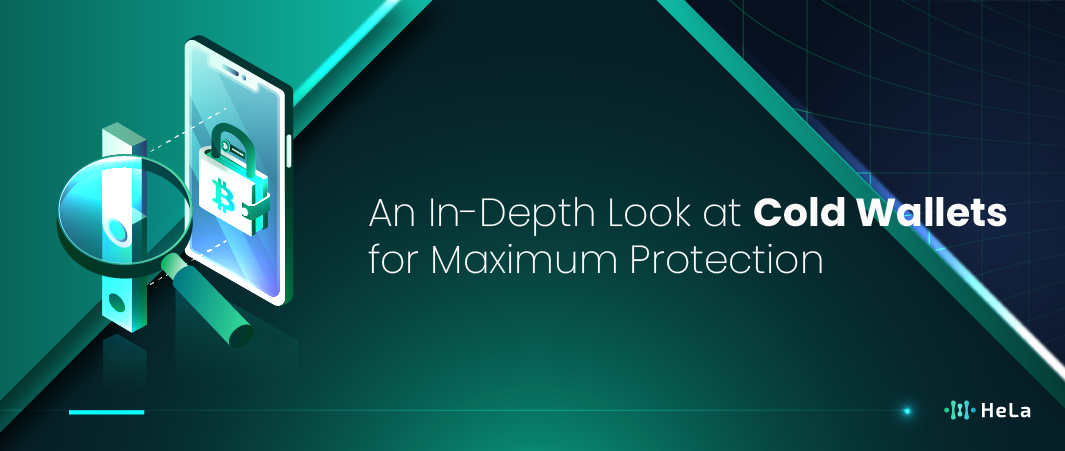Cryptocurrency security is more important than ever, especially with the growing risks of hacking and theft in the digital world. One of the best ways to protect your digital assets is by using a cold wallet, a method of storing your private keys offline to prevent unauthorized access. What is Cold Wallets? Best Option For Maximum Cryptocurrency Protection, and how do they work?, this article will guide you through the different types of cold wallets—hardware wallets, paper wallets, and air-gapped computers—and explain how each option can provide the safety you need for long-term storage of your crypto.
In addition to understanding how cold wallets work, we’ll also walk you through the process of creating one that fits your needs. From simple paper wallets to more advanced hardware and air-gapped solutions, this guide covers everything you need to know to safeguard your crypto. If you’re serious about keeping your digital assets secure, keep reading to learn how to choose the right cold wallet and set it up correctly. The steps outlined here will give you peace of mind knowing your cryptocurrency is safe from online threats.
What is Cold Wallet?

A cold wallet is a device or method for storing cryptocurrency assets that functions offline. The term “cold” refers to the fact that this wallet is not directly connected to the internet, making it much more secure from cyber threats like hacking and malware. Cold wallets come in various forms, including physical hardware devices (hardware wallets) or even a piece of paper (paper wallet) that contains the private key used to access and manage the cryptocurrency assets. The main purpose of a cold wallet is to protect your digital assets from online threats, as access to it can only be done manually, usually through a computer that is also not connected to the internet.
Technically, a cold wallet stores the private key required to access and control cryptocurrency assets. The private key is a critical cryptographic code because whoever has access to it can control the associated crypto assets. Cold wallets keep this private key safe from cyber attacks. Typically, hardware wallets like Trezor or Ledger are used for this storage, where users must physically connect the device to move assets. Since these wallets are not connected to the internet when not in use, the chances of them being hacked are almost zero.
However, despite the high level of security that cold wallets offer, there are some drawbacks to consider. Accessing the assets becomes more complicated and takes longer compared to hot wallets, which are always online and easy to use. Users must connect the device to a computer or manually input information from a paper wallet to access their funds. This makes cold wallets more suitable for long-term storage or for those holding large amounts of assets and seeking maximum security.
In the evolving world of crypto, cold wallets are an ideal solution for those who prioritize security over convenience. Though not without challenges, such as the risk of losing the physical device or paper, cold wallets remain the top choice for protecting digital assets from hacking threats. For serious crypto holders, having a cold wallet is a wise step in securing their digital portfolio.
How Does Cold Wallet Works?

A cold wallet works by keeping your cryptocurrency private keys completely offline, away from the reach of hackers or malicious software that could compromise your assets. When you own cryptocurrency, you don’t actually hold the coins themselves, what you possess are the private keys that grant you access to your assets on the blockchain. A cold wallet securely stores these private keys on a physical device or in a format that is never exposed to the internet. This isolation from online connections is the core of how a cold wallet protects your funds, making it one of the safest methods for long-term storage.
The cold wallet process begins when you generate a new wallet, either through hardware or a software that is designed to create wallets offline. This generation produces a pair of cryptographic keys: a private key and a public key. The private key is the sensitive piece of data that must never be shared, as it gives full control over your funds. The public key, on the other hand, is shared with others to receive cryptocurrency. When you want to store assets in a cold wallet, you send them to the public key address, and they are securely locked away, with the private key kept offline.
When you need to access your cryptocurrency stored in a cold wallet, the process becomes a bit more involved compared to a hot wallet. First, you have to physically connect the cold wallet, like a USB device, to your computer or manually enter the private key if using a paper wallet. The wallet software will allow you to sign a transaction (using the private key) without exposing the key to the internet. Once the transaction is signed, you can send the signed transaction back to the online network. The private key remains offline throughout this process, ensuring its safety even during the transaction.
Also Read: Best Bitcoin Wallets: Top 10 Bitcoin Wallets to Consider in 2024
Cold wallets are particularly useful for those who hold large amounts of cryptocurrency or want to keep their assets in storage for long periods without frequent access. While the process of retrieving or moving funds may be slower, this inconvenience is a trade-off for the heightened security. The fact that the private key never touches an online environment significantly reduces the risk of hacking, phishing, or other cyber threats, making cold wallets one of the most trusted methods for safeguarding digital wealth.
Type of Cold Wallet

Cold wallets come in various types, each with unique methods to keep your cryptocurrency private keys safe offline. These wallets offer high security against cyberattacks and hacking attempts since they do not connect to the internet. Cold wallets are ideal for long-term storage or for people who hold large amounts of crypto and prioritize security over convenience. The different types of cold wallets cater to varying needs, from simple paper-based solutions to advanced hardware devices. Below are some type of cold wallets, along with their advantages and considerations:
Hardware Wallets
These are physical devices, often resembling USB drives, built to store your private keys securely. Popular brands like Ledger Nano and Trezor offer robust solutions for managing multiple cryptocurrencies. With hardware wallets, transactions are signed inside the device itself, meaning your private keys never touch the internet.
When you need to make a transaction, you connect the wallet to your computer, sign the transaction, and then disconnect it. The device ensures that even if the computer is compromised by malware, your private keys remain safe. Hardware wallets are known for being one of the most secure cold wallet options due to their physical nature and the security features built into the devices.
Paper Wallets
This type of wallet involves printing out both your private and public keys on a physical piece of paper, usually as QR codes. You can store cryptocurrency by sending it to the public key address, while the private key remains on the paper, away from any digital threats. Paper wallets are appealing because they are easy to generate using trusted offline wallet generators, and they don’t cost anything.
However, their security depends entirely on how well you can protect the paper itself. If the paper is lost, damaged, or falls into the wrong hands, there’s no way to recover your funds. This method is best suited for those who want an extremely cost-effective way to secure their crypto offline but are also diligent about protecting the physical copy.
Also Read: Crypto Wallet Development: Best Practices and Techniques
Air-Gapped Computers
These are computers that are deliberately never connected to the internet, making them entirely isolated from online threats. Air-gapped computers are typically used for creating and storing cryptocurrency wallets and private keys. To execute a transaction, you transfer the signed transaction from the air-gapped computer to an online device using external media, like a USB drive.
This method is favored by people with high-value crypto holdings who prioritize top-tier security, although it requires more technical know-how and can be time-consuming. Air-gapped computers ensure the highest level of isolation, but the setup can be complex for non-technical users.
Special Devices or Methods
Some users opt for more advanced cold storage solutions, such as Hardware Security Modules (HSMs) or multi-signature (multisig) wallets. HSMs are physical devices used to manage and protect cryptographic keys, often used by institutions or high-net-worth individuals.
Multisig wallets, on the other hand, require multiple private keys from different devices or locations to approve a transaction, adding an extra layer of security. These specialized methods are highly secure but also require more advanced knowledge to set up and maintain. They are best suited for users who require enhanced protection for large-scale crypto investments or institutional use.
Ways to Create Cold Wallet From Each Type
Creating a cold wallet involves taking steps to ensure that your private keys are generated and stored in an offline environment, providing maximum security for your cryptocurrency. Cold wallets are used to store digital assets safely, away from internet threats like hacking and malware. Below is a guide on how to create a cold wallet, including the different methods you can choose from and the steps involved in the process:
From Hardware Wallet
The simplest and most popular method of creating a cold wallet is by using a hardware wallet. To get started, you’ll need to purchase a reputable device like Ledger or Trezor. Once you have the hardware wallet, the first step is to connect it to your computer via USB. The device will guide you through the setup process using its own software. During this setup, you will create a new wallet, which includes generating both your private and public keys.
A crucial part of the setup is receiving your recovery seed phrase, which serves as your backup in case the device is lost or damaged. It’s vital to write this seed phrase down and store it in a secure, offline location, as it’s the only way to recover your wallet. Once everything is configured, your hardware wallet will securely store your private keys, ensuring they remain offline. You can then use your wallet to store cryptocurrency safely, with transactions only being signed and authorized when the device is physically connected to your computer.
From Paper Wallet
A paper wallet is another form of cold storage where you print out your private and public keys on paper, providing an offline method to store your cryptocurrency. To create a paper wallet, start by visiting a trusted offline wallet generator, like BitAddress.org or WalletGenerator.net. These services allow you to generate a wallet in a secure offline environment. For even greater security, it’s recommended to download the generator’s source code and run it on an air-gapped computer, which is a device that is never connected to the internet. Once you’ve done this, you can generate a private and public key pair offline. The keys will be displayed both as alphanumeric codes and QR codes.
After generating the keys, print them out on a piece of paper. It’s critical to store this paper in a secure, fireproof, and waterproof location to protect it from damage. You may also want to create multiple copies and store them in separate secure locations for backup. Your cryptocurrency remains securely offline as long as the paper wallet is stored safely. To access the funds later, you’ll need to import the private key into a hot wallet (an online wallet), but until then, your assets are fully protected offline.
From Air-Gapped Computer
For the highest level of security, you can use an air-gapped computer to create a cold wallet. First, you’ll need a computer that has never been connected to the internet. To ensure it’s completely clean, wipe the device and reinstall the operating system. This way, you eliminate any risk of pre-existing malware. Next, using a separate computer with internet access, download an offline wallet generator or software like Electrum onto a USB drive. Transfer the software to the air-gapped computer via the USB and run the wallet generation tool to create your wallet completely offline.
Once you’ve generated the wallet, you can store the private keys on the air-gapped computer itself, save them to a USB drive, or even print them out as a paper wallet. Just make sure to create multiple backups and store them securely. Since this computer will never connect to the internet, it drastically reduces the risk of hacking. If you need to sign any transactions, you can do so offline on the air-gapped computer, and then use external media, like a USB, to transfer the signed transaction to an online device for broadcasting. This method offers the ultimate protection for your digital assets.
From Special Devices: Multi-Signature (Multisig)
If you’re looking for an extra layer of security, setting up a multi-signature cold wallet is a great option. In this type of wallet, multiple private keys are needed to authorize any transaction, adding a significant level of protection. Start by selecting a wallet that supports multisig functionality, such as Electrum or hardware wallets like Trezor or Ledger. Next, generate multiple private keys using different methods, like hardware wallets, paper wallets, or even an air-gapped computer.
Once you’ve got your keys, configure the multisig wallet to require a specific number of them (for example, 2 out of 3 or 3 out of 5) to approve any transaction. For maximum security, store each private key in a separate, secure location, ensuring that no single person has access to all the keys. This setup means that even if one key is compromised, it won’t be enough to access your funds without the others. It’s a simple yet powerful way to significantly reduce the risk of unauthorized access to your cryptocurrency.
Conclusion
Cold wallets offer one of the safest methods for storing cryptocurrency by keeping your private keys offline, away from the reach of hackers and online vulnerabilities. Whether you choose a hardware wallet, paper wallet, air-gapped computer, or a multi-signature setup, each option provides a strong layer of security to protect your digital assets. What is Cold Wallets? Best Option For Maximum Cryptocurrency Protection comes down to understanding which type of cold wallet fits your needs and how to set it up correctly. Each method has its strengths, but the core principle is the same: maintaining control over your private keys in a secure, offline environment.
By following the steps outlined in this article, you can create a cold wallet tailored to your security preferences. The key to long-term crypto protection lies in careful handling of private keys, storing backups in secure locations, and understanding the benefits of multi-signature wallets if you want added layers of security. With these strategies, you can confidently safeguard your assets, reducing the risk of theft and ensuring that your cryptocurrency remains secure for the future.
Disclaimer: The information provided by HeLa Labs in this article is intended for general informational purposes and does not reflect the company’s opinion. It is not intended as investment advice or a recommendation. Readers are strongly advised to conduct their own thorough research and consult with a qualified financial advisor before making any financial decisions.

